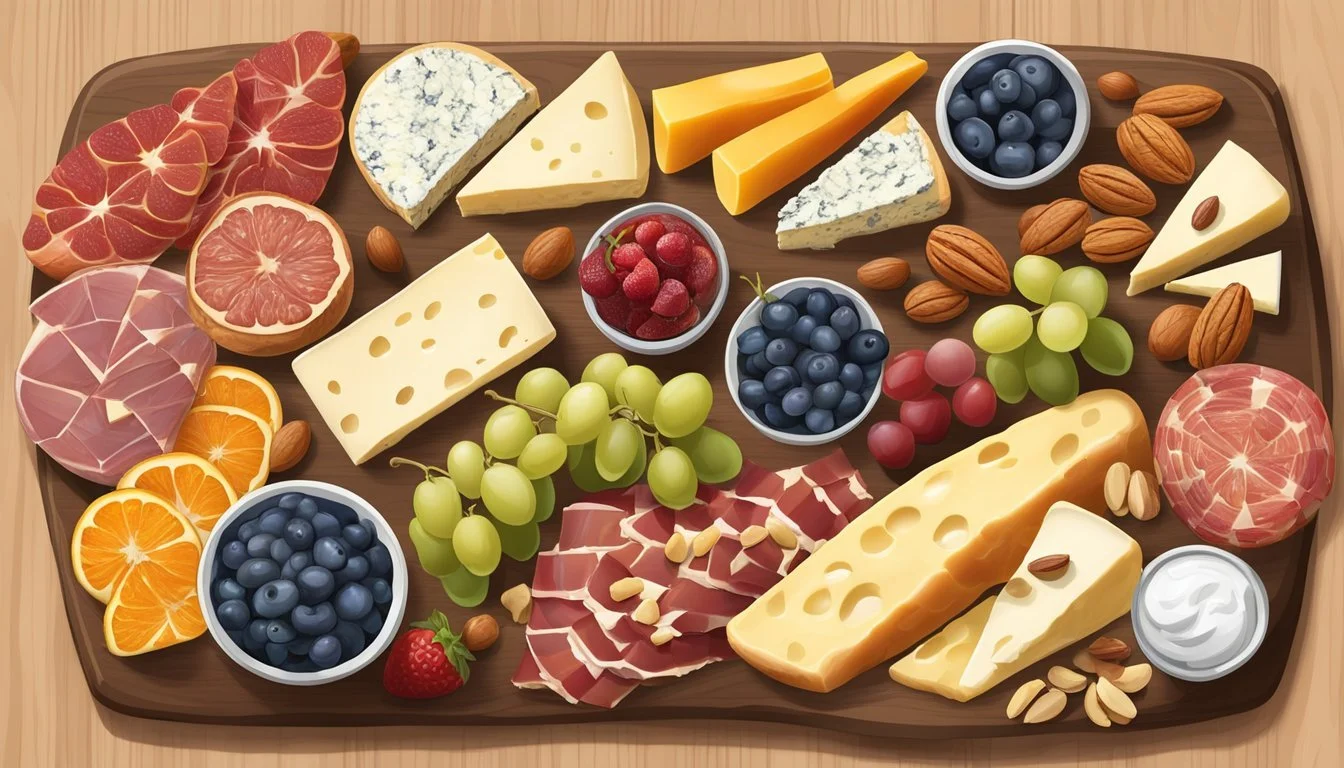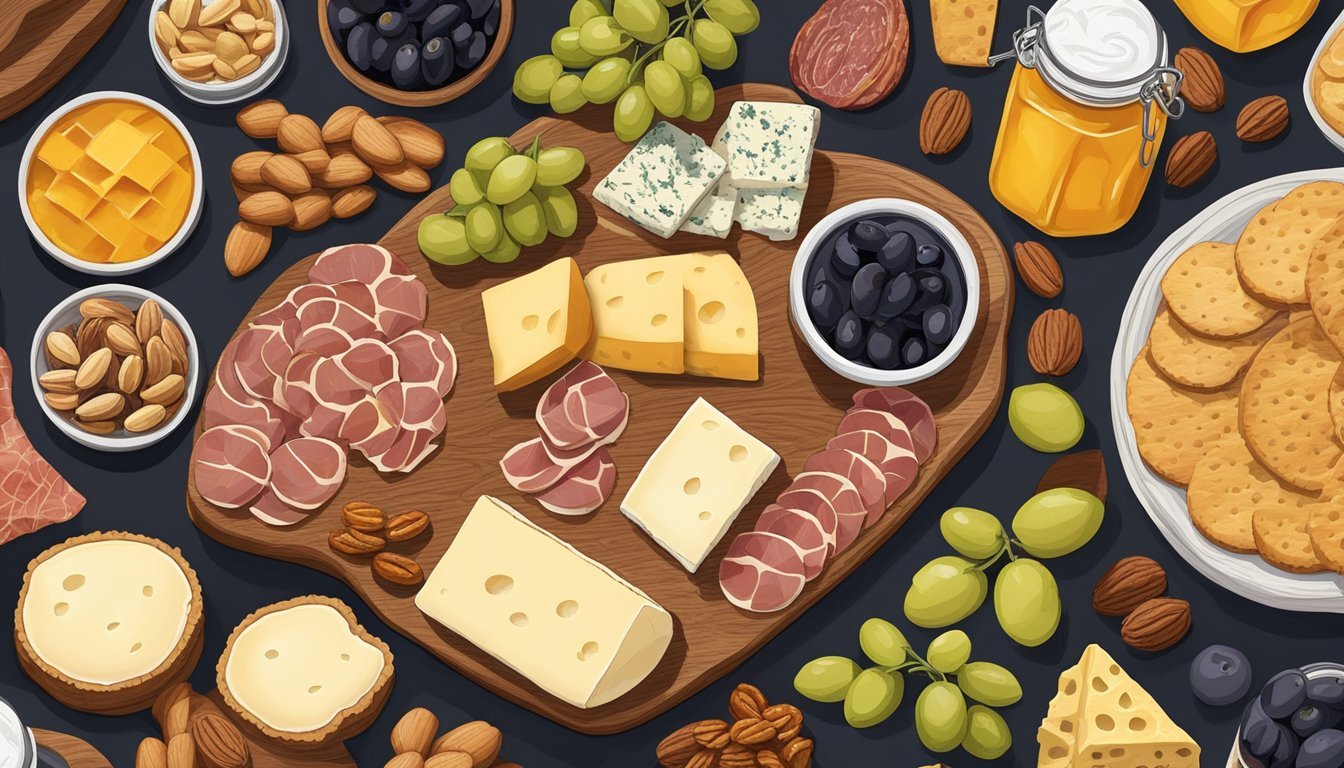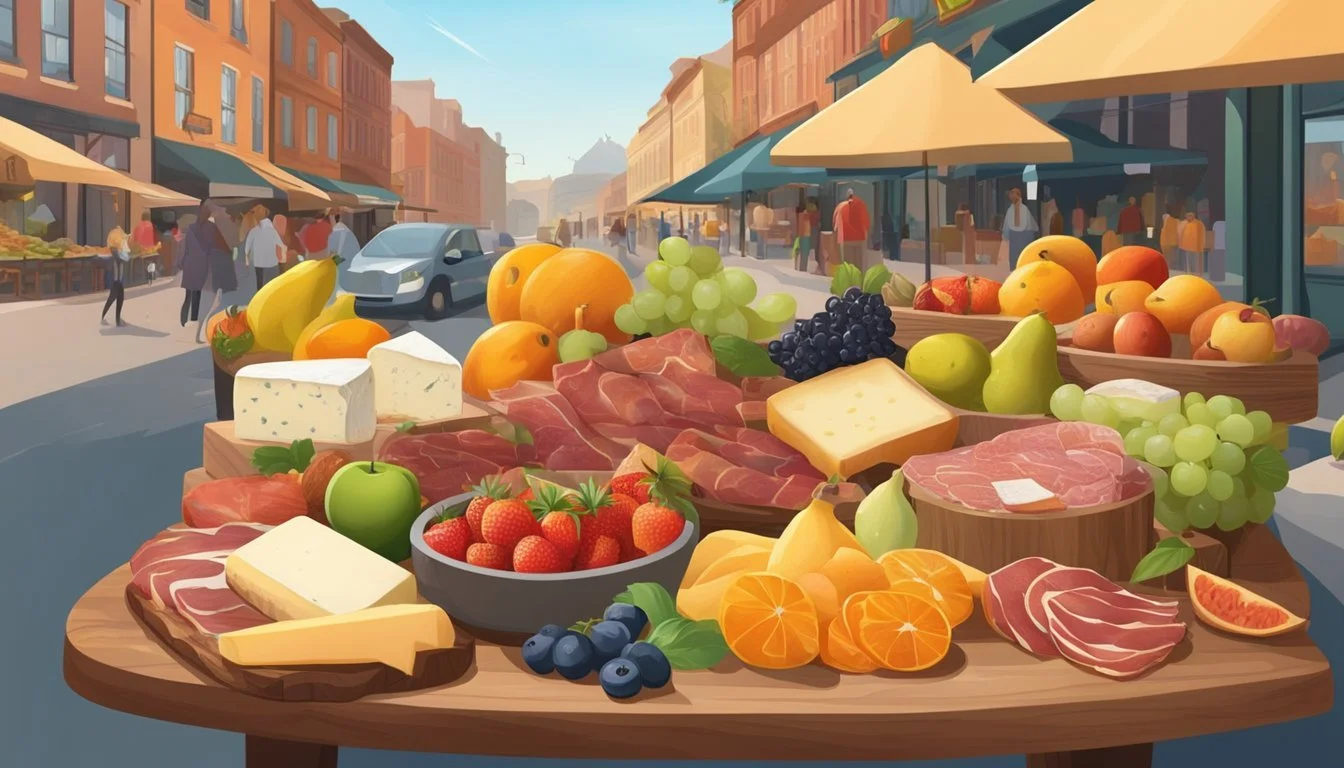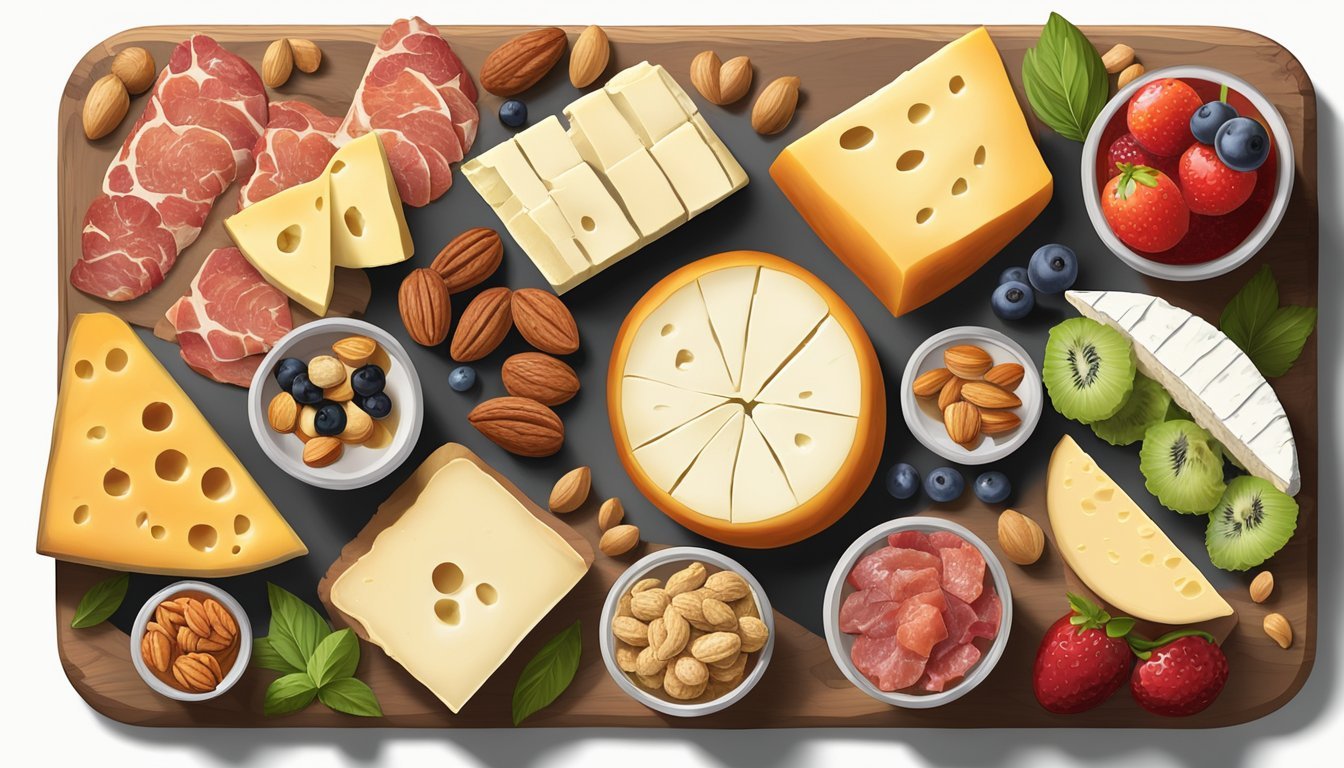The Best Farmers' Market Products for a Charcuterie Board
Selecting Premium, Fresh Ingredients
Crafting the perfect charcuterie board starts with selecting top-quality ingredients that complement each other in flavor, texture, and appearance. Farmers' markets are ideal destinations for curating such a board, as they offer a diverse range of fresh, locally-sourced produce and artisanal goods that can elevate the simplest of gatherings to a memorable culinary experience.
A farmers' market offers access to products that are not only fresh but also unique to the region, providing an opportunity to create a charcuterie (What wine goes well with charcuterie?) board with a distinct local flair. Items like handcrafted cheeses, cured meats (What wine goes well with cured meats?) from local butchers, and a variety of pickled vegetables (What wine goes well with pickled vegetables?) can be combined to showcase the region's gastronomic diversity. Freshly baked breads, seasonal fruits, and small-batch preserves add layers of texture and taste, ensuring a well-rounded selection.
The beauty of a farmers' market-driven charcuterie board lies in the celebration of seasonal produce and the support of local farmers and producers. The choices made at the market will reflect the peak produce of the current season, guaranteeing flavors that are at their most vibrant. Assembling a board with these elements not only promises a delicious spread but also tells a story of the community's agricultural heritage and dedication to sustainability.
Essentials of Charcuterie Boards
The creation of a charcuterie board is an art form that involves the careful selection of materials and understanding of design principles to elevate the presentation of cured meats, cheeses, and accompaniments.
Understanding Charcuterie Board Basics
A charcuterie board serves not only as a platform for displaying an assortment of savory delicacies but also as a statement piece at social gatherings. To fully appreciate its role, one should be aware that it's about pairing the right flavors and textures while also considering visual appeal. The essentials for a charcuterie board include a variety of meats like prosciutto and salami, assorted cheeses ranging from soft to hard, and various accompaniments such as nuts, fruits, olives, (What wine goes well with olives?) and artisanal bread.
Choosing the Right Cutting Board Material
When selecting a cutting board, durability and hygiene must be taken into account. Hardwoods such as maple, cherry, or walnut are ideal due to their resistance to cuts and scratches, which also helps in preventing bacteria from settling in. These woods are known for their longevity and ease of cleaning, which are essential attributes for regular use.
Selecting the Ideal Board Size and Shape
Size and shape play crucial roles in the functionality and aesthetics of a charcuterie board. The board should be spacious enough to accommodate the variety of foods without overcrowding:
Small (Under 12 in.): Suitable for intimate gatherings.
Medium (12 to 18 in.): Ideal for small parties.
Large (Over 18 in.): Best for larger events.
Shapes can range from classic rectangles and rounds to more unique live-edge designs that add a natural look. Rectangular boards are preferred for their space efficiency, while round boards may create a more central focal point on a table.
Key Components of a Charcuterie Board
A charcuterie board combines diverse flavors and textures, including a range of cheeses and meats complemented by fruits, nuts, and various spreads, to create a delightful culinary experience. Each element is selected to complement the others, ensuring a balance between savory, sweet, and tangy.
Variety of Cheeses
The cheese selection is foundational to any charcuterie board. It typically includes a mix of hard cheeses like aged cheddar, soft cheeses (What wine goes well with soft cheeses?) such as brie or camembert, and aromatic options like blue cheese. A well-rounded board may feature:
Hard Cheese: Aged Cheddar, Manchego, Gruyère
Soft Cheese: Brie, Goat Cheese, Camembert
Selection of Cured Meats
Cured meats add a savory depth to the board. Classics like salami and prosciutto are often thinly sliced to enhance their flavor. Options can include:
Salami: Known for its robust flavor and firm texture.
Prosciutto: A delicate, thinly-sliced Italian ham with a silky texture.
Inclusion of Fresh and Dried Fruits
Fruits provide a sweet counterpoint to the savory meats and cheeses. They can include seasonal selections, such as grapes or figs, and a range of dried fruits for concentrated sweetness. Examples are:
Fresh Fruit: Grapes, Figs, Apple Slices
Dried Fruit: Apricots, Dates, Figs
Assortment of Nuts and Accompaniments
Nuts add crunch and a nutty flavor, while other accompaniments like olives and jams offer a tangy or sweet note. Select from:
Nuts: Almonds, Walnuts, Pistachios
Accompaniments: Green Olives, Fig Jam, Honeycomb
Options for Breads and Crackers
Breads and crackers provide a base for assembling bites. They should be neutral enough to not overpower the flavors of the toppings. Include:
Breads: Baguette slices, artisanal breads
Crackers: Whole grain, water crackers, crispbread
Savory Spreads and Condiments
Spreads like hummus and tapenade can be used to add a layer of flavor. They pair well with both the breads and the other charcuterie components. Consider:
Hummus: A creamy spread made from chickpeas
Tapenade: A savory olive paste that pairs well with meats and cheeses
Crafting the Perfect Presentation
Crafting an impeccable presentation for a charcuterie board elevates the enjoyment of the carefully selected farmers' market products. Here, details such as aesthetic design, appropriate utensils, and ideal serving temperature are dissected to ensure each element is showcased and served at its peak.
Aesthetic Arrangement and Design Tips
The visual appeal of a charcuterie board lies in its composition and the harmony between colors, textures, and shapes. Start by placing the largest items, usually cheeses and meats, in a staggered fashion to act as anchor points on the board. Ensure to fill the gaps with smaller accompaniments like nuts and fruits, creating a seamless look without empty spaces. To enhance visual interest, consider drapes of sliced meats and clusters of grapes or berries. A drizzle of honey or balsamic glaze not only adds a layer of flavor but also contributes to the board's overall aesthetics.
Selecting the Right Cheese Knives and Tools
Proper cheese knives are essential for both presentation and ease of serving. Each cheese type has an ideal knife: a soft cheese knife for Brie or Camembert, which has holes to prevent sticking; a chisel knife for crumbly cheeses like Gorgonzola; and a hard cheese knife for aged Cheddar or Parmesan. Displaying these knives alongside their corresponding cheeses signals knowledgeable preparation and invites guests to help themselves efficiently.
Soft Cheese Knife: Best for Brie, Camembert
Chisel Knife: Suited for Gorgonzola, Blue cheeses
Hard Cheese Knife: Ideal for Cheddar, Parmesan
Serving Temperature and Preparation
Cheeses should be served at room temperature, which typically means removing them from refrigeration one hour prior to serving. This enhances both the flavor and the texture, making cheeses more spreadable and savory. For meats, they should be kept cool but not cold, as excessive chill can diminish their nuanced flavors. It's critical to balance the serving temperature to respect the integrity of the farmers' market products while ensuring food safety.
Complementary Pairings and Flavors
When crafting a charcuterie board from farmers' market products, one must aim for a balance of flavors and pairings that accentuate the quality of each item chosen.
Aligning Textures and Tastes
The key to a successful charcuterie board lies in the artful alignment of textures and tastes. Robust, aged cheeses (What wine goes well with aged cheeses?) pair well with the rich, bold flavors of artisanal salami. For a contrast in texture, one might couple creamy goat cheese with crispy herb crackers. Items should complement each other, creating a layered experience of both contrast and harmony.
Hard Cheeses: Match with dry-cured meats for a satisfying crunch.
Soft Cheeses: Balance with rustic, chewy breads or tangy fruit preserves.
Creating a Harmony Between Sweet and Savory
Striking the right balance between sweet and savory elements is essential. Introducing honeycomb or fruit jams not only adds a burst of sweetness but also a refreshing contrast to the savory meats and cheeses. Accompanying sour items like cornichons or pickled vegetables can cut through the richness and cleanse the palate.
Sweet Components: Fresh figs, apple slices, or dark chocolate.
Sour Elements: Pickled onions, olives, or artisanal mustards.
Wine and Beverage Pairings
No charcuterie board is complete without thoughtful beverage pairings. A crisp white wine brings out the subtlety in soft cheeses while a bold red can stand alongside the complex flavors of aged meats. Local craft beers or ciders can also provide a refreshing counterpoint to a richly laden board.
White Wines: Good with soft cheeses and seafood-based charcuterie.
Red Wines: Best matched with strong-flavored meats and aged cheeses.
Seasonal and Thematic Variations
When constructing a charcuterie board, one can enhance its appeal by tailoring the selection to align with specific seasons and themes, ensuring each board is both unique and fitting for the occasion.
Holiday-Themed Charcuterie Ideas
For the holidays, one should think of incorporating items that resonate with the festive spirit. Winter holidays often call for boards featuring rich flavors like figs, clementines, and cranberries, alongside traditional meats like Genoa salami known for its spice profile. Adding pistachios and chocolates can round out the holiday board with a celebratory flair.
Seasonal Produce Selections
Selecting produce that is at the peak of its season not only guarantees the freshest taste but also supports local farmers. For autumn, choose pears and apples that can complement meats such as prosciutto. In summer, fresh berries and stone fruits add a sweet and vibrant touch. Vegetables like pickled cucumbers or roasted red peppers can bring color and texture to the board.
Thematic Decor and Elements
The charcuterie board’s aesthetic can parallel the theme of the event it is serving. For instance, a fall harvest board could include elements like maple leaves or mini pumpkins as decor. For a bridal shower or wedding, edible flowers and a selection of heart-shaped cheeses might be suitable. The presentation should include relevant colors, patterns, and decor to emphasize the intended theme.
Extended Charcuterie Options
Beyond traditional meats and cheeses, charcuterie boards can be adapted to cater to a sweet tooth or dietary preferences such as vegetarianism and veganism. Farmers' markets are ideal venues for sourcing fresh, artisanal components for these more specialized boards.
Crafting a Dessert-Focused Board
One can transform the charcuterie concept into a delightful dessert board by selecting products like fresh, seasonal fruits and local honey from the farmers' market. Artisanal chocolates and small-batch preserves also make excellent additions. For those who bake, adding homemade items such as miniature tarts or scones highlights a personal touch.
Suggested Products for a Dessert Board:
Seasonal Fruits (e.g., Strawberries, Figs)
Local Honey or Agave Syrup
Handmade Chocolates
Gourmet Preserves and Fruit Compotes
Mini Pastries or Fruit Tarts
Incorporating Vegetarian and Vegan Varieties
Farmers' markets offer an abundance of fresh vegetables, which can become the centerpiece of a vegetarian or vegan charcuterie board. For instance, one might pick up a variety of olives, stuffed peppers, and artichokes. (What wine goes well with artichokes?) For protein, seasoned tofu, tempeh, or a selection of nuts and seeds are excellent vegan-friendly choices.
Key Components for Vegetarian/Vegan Boards:
Raw or Pickled Vegetables
Artisanal Vegan Cheese Substitutes
Hummus and Other Plant-Based Dips
Marinated Tofu or Tempeh
Assortment of Nuts and Seeds
Advanced Charcuterie Techniques
Charcuterie boards have evolved into elaborate displays of culinary artistry, and mastering advanced techniques ensures that one's spread is as much a visual feast as it is a delectable appetizer. This section focuses on sophisticated methods for creating charcuterie boards designed to impress at large gatherings and offers professional insights for elevating home entertainment.
Charcuterie for Large Gatherings
For large gatherings, an oversized charcuterie board serves as both a bountiful appetizer and a decorative centerpiece. Professionals focus on a few key strategies:
Variety and Abundance: Crafting a board with a diverse assortment of meats, cheeses, and accompaniments caters to every palate. Balance is critical.
Category Suggestions Meats Prosciutto, salami, chorizo Cheeses Brie, gouda, cheddar Plant-based Nuts, olives, hummus Fruits Grapes, figs, berries Vegetables Carrots, cherry tomatoes Crunch Crackers, breadsticks Dips Artisanal jams, honeycomb
Preparation: Each item should be prepared in advance. Meats can be rolled or folded, and cheeses pre-sliced or arranged in wedges.
Layout: Large boards benefit from designated sections, creating visual interest and guiding guests as they graze.
Professional Tips and Tricks for Home Entertainment
When entertaining at home, attention to detail transforms a simple spread into an immersive experience. Pro tips include:
Texture and Color: Add visual appeal by contrasting creamy cheeses against rustic breads, or pairing vibrant fruits with muted nuts and chocolates.
Intentional Placement: Design the board's layout so that complementary flavors are adjacent, encouraging guests to try pairing suggestions.
Innovative Recipes: Incorporate homemade items like candied walnuts or pickled vegetables, elevating the board's uniqueness.
Artistic Touches: Use fresh herbs or edible flowers to add natural beauty and subtle flavors.
One's charcuterie board becomes more than just an appetizer; it's a conversation starter and an essential element of home entertainment.
Maintenance and Care of Charcuterie Accessories
Caring for charcuterie accessories prolongs their lifespan and ensures they remain safe for food presentation. Proper cleaning, storing, and preserving techniques are essential.
Cleaning and Storing Cheese Knives
Cheese knives should be hand washed with warm, soapy water promptly after use to prevent any cheese or accompaniment residue from hardening. They should never be left soaking in water as this can damage the handles and blade. Once washed, carefully dry them with a towel. For storage, a knife block or a dedicated drawer with an inlay can protect the blades and prevent accidents.
Cleaning Steps:
Rinse to remove leftovers.
Gently scrub with a soft sponge.
Rinse again with warm water.
Dry immediately.
Storage Tips:
Use a knife block.
Opt for a drawer with a knife organizer.
Keep away from other utensils to prevent dulling.
Preserving Your Wooden or Stone Boards
Wooden boards can last for years when treated with care. After each use, wooden boards should be washed with warm water and a soft scrub brush; then, they should be dried thoroughly. For maintenance, apply food-grade mineral oil once a month to keep the wood conditioned and prevent it from drying out or cracking.
Wash: Use warm, soapy water.
Dry: Pat down with a clean cloth and let it air dry standing up.
Condition: Apply food-grade mineral oil monthly.
Stone boards, such as marble or slate, require less maintenance than wooden boards. They should be wiped clean with a damp cloth, dried immediately, and can be lightly sanitized with a solution of water and vinegar. Unlike wood, stone does not need oiling but requires careful handling to prevent chipping.
Clean: Wipe with a damp cloth.
Dry: Use a dry microfiber cloth.
Protect: Handle with care to avoid chips.









